Report on Logistics Management at Philips Electronics Singapore
VerifiedAdded on 2020/03/23
|13
|2486
|229
Report
AI Summary
This business report examines the logistics department of Philips Electronics Singapore Pte. Ltd., focusing on its interface with core company functions and identifying areas for improvement. The report details the logistics management process, including interactions with sales and marketing, finance and accounts, and production. It analyzes the order cycle, highlighting challenges in planning and recommending solutions like improved demand and inventory planning. The report also addresses inventory management issues, such as manual processes leading to errors, and proposes implementing a state-of-the-art real-time inventory tracking system. Recommendations include a robust automated ERP system, inventory classification, system integration for visibility, and process automation to enhance efficiency, reduce costs, and improve customer service. The conclusion emphasizes the importance of aligning supply chain processes with business objectives for competitive advantage.

Paraphrase This Document
Need a fresh take? Get an instant paraphrase of this document with our AI Paraphraser
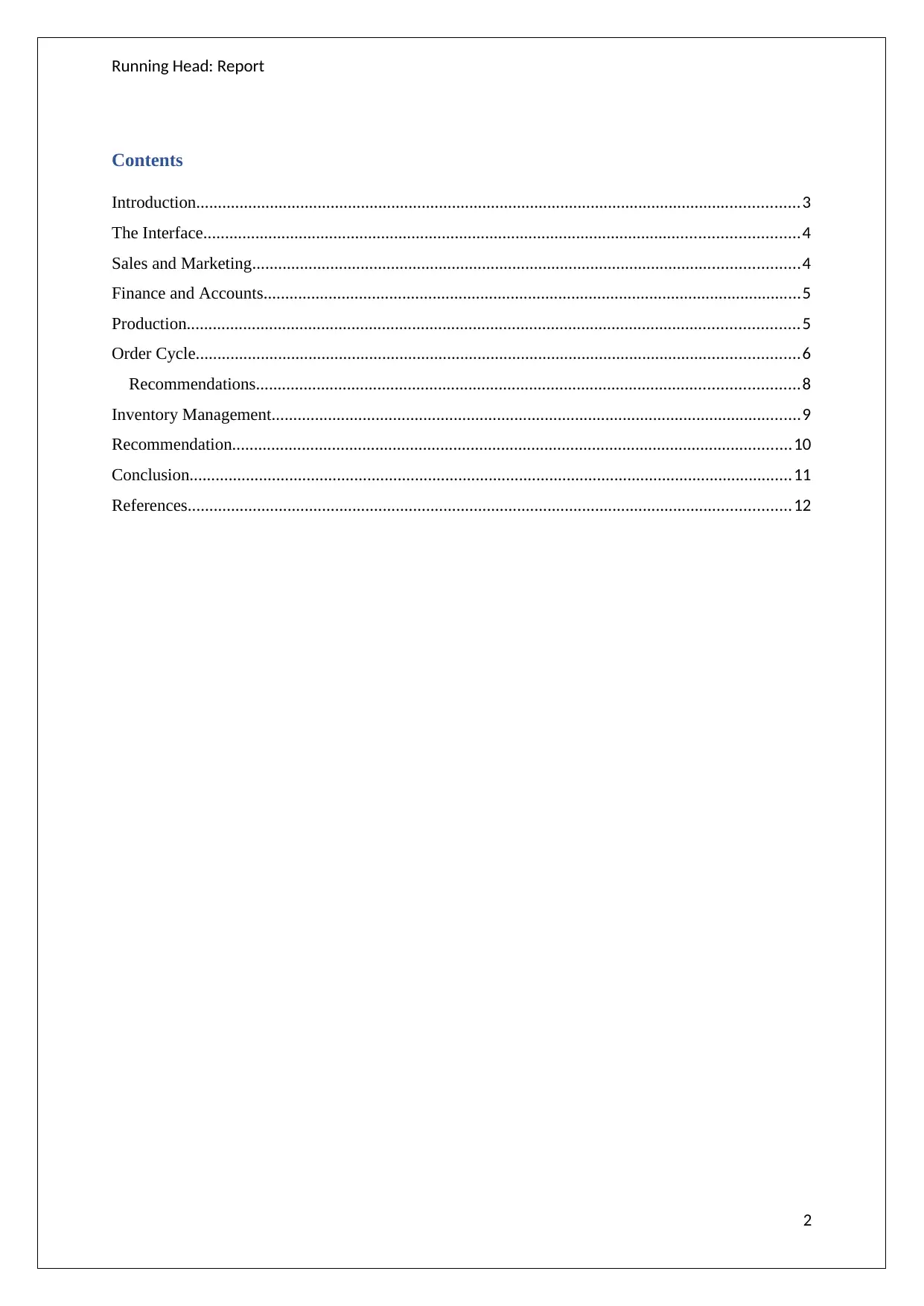
Running Head: Report
Contents
Introduction...........................................................................................................................................3
The Interface.........................................................................................................................................4
Sales and Marketing..............................................................................................................................4
Finance and Accounts............................................................................................................................5
Production.............................................................................................................................................5
Order Cycle...........................................................................................................................................6
Recommendations.............................................................................................................................8
Inventory Management..........................................................................................................................9
Recommendation.................................................................................................................................10
Conclusion...........................................................................................................................................11
References...........................................................................................................................................12
2
Contents
Introduction...........................................................................................................................................3
The Interface.........................................................................................................................................4
Sales and Marketing..............................................................................................................................4
Finance and Accounts............................................................................................................................5
Production.............................................................................................................................................5
Order Cycle...........................................................................................................................................6
Recommendations.............................................................................................................................8
Inventory Management..........................................................................................................................9
Recommendation.................................................................................................................................10
Conclusion...........................................................................................................................................11
References...........................................................................................................................................12
2

Running Head: Report
Introduction
This business report is compiled to study the logistics department of Philips Electronics
Singapore Pts. Ltd., how this department interfaces with various other core functions of the
company. The report will cover the logistics management process of the company and further
analysing them to identify improvement areas.
Logistics management in a company is a process that involves planning, implementing,
controlling the flow and storage of products and services from the point of origin to the
customer. There are a few reasons to measure logistics, one is for reduction in operating cost,
for revenue growth and for enhancing the shareholder value. Analysis of the operating cost
helps to control expenses and identify areas of improvement in asset management, Service
improvement in logistics activities helps in retaining valuable customers and logistics
performance is directly linked to the shareholder investments and market value of the firm.
Philips Electronics Singapore Pte. Ltd. manufactures electronic products which include sound
and vision products, personal care products, domestic appliances, child care products,
lighting equipment’s, healthcare products and accessories. The company was incorporated in
1951 and was earlier known as Philips Consumer Communications Asia Pacific Pte. Ltd. As
a manufacturer, the goals of Philips Electronics Singapore are also to continuously grow and
attain a competitive edge by continuously delivering innovative products while minimizing
the cost (Philips Team, 2017).
3
Introduction
This business report is compiled to study the logistics department of Philips Electronics
Singapore Pts. Ltd., how this department interfaces with various other core functions of the
company. The report will cover the logistics management process of the company and further
analysing them to identify improvement areas.
Logistics management in a company is a process that involves planning, implementing,
controlling the flow and storage of products and services from the point of origin to the
customer. There are a few reasons to measure logistics, one is for reduction in operating cost,
for revenue growth and for enhancing the shareholder value. Analysis of the operating cost
helps to control expenses and identify areas of improvement in asset management, Service
improvement in logistics activities helps in retaining valuable customers and logistics
performance is directly linked to the shareholder investments and market value of the firm.
Philips Electronics Singapore Pte. Ltd. manufactures electronic products which include sound
and vision products, personal care products, domestic appliances, child care products,
lighting equipment’s, healthcare products and accessories. The company was incorporated in
1951 and was earlier known as Philips Consumer Communications Asia Pacific Pte. Ltd. As
a manufacturer, the goals of Philips Electronics Singapore are also to continuously grow and
attain a competitive edge by continuously delivering innovative products while minimizing
the cost (Philips Team, 2017).
3
⊘ This is a preview!⊘
Do you want full access?
Subscribe today to unlock all pages.

Trusted by 1+ million students worldwide

Running Head: Report
The Interface
Logistics includes a wide range of areas and interlinked tasks. Money invested in an
organization supply chain function affects almost every department of the organization. This
can be said in terms of the process flow and the tasks linkage with one or the other
department, which also increases the interdepartmental coordination. An internal functional
integration is important so as to produce and deliver as per customer demands. Before the
concept of Integrated Logistics, the companies considered production and marketing as the
core functions and all others as support functions. But, with this concept coming in, the
interface increased and few of the responsibilities gets co-managed by production, marketing
and logistics departments (Tseng & Yue, 2005).
Interface with the shippers at warehouse happens when product has to reach to the customers,
an interface with the finance and accounts happens to bill payments, similarly with the
customer support function happens to order processing status. Below is the description of
ways how the logistics department interfaces with the core functions of Philips Electronics.
Sales and Marketing
Saving costs from one or the other way in supply chain, like Kaizen, implementation in
Philips, could explore reaching out to the previously unattainable markets, which increases
the opportunity to grow their sales and increase the customers.
Business process management has a wide focus on managing relationships, wherein it
measures its success in terms of business transactions with the customers through order
fulfillments. Thus, raising an awareness about customer retention. Its economic theory,
means that, to have a cost effective method, it is always better to have multiple transactions
with the same customer rather than obtaining a new customer.
4
The Interface
Logistics includes a wide range of areas and interlinked tasks. Money invested in an
organization supply chain function affects almost every department of the organization. This
can be said in terms of the process flow and the tasks linkage with one or the other
department, which also increases the interdepartmental coordination. An internal functional
integration is important so as to produce and deliver as per customer demands. Before the
concept of Integrated Logistics, the companies considered production and marketing as the
core functions and all others as support functions. But, with this concept coming in, the
interface increased and few of the responsibilities gets co-managed by production, marketing
and logistics departments (Tseng & Yue, 2005).
Interface with the shippers at warehouse happens when product has to reach to the customers,
an interface with the finance and accounts happens to bill payments, similarly with the
customer support function happens to order processing status. Below is the description of
ways how the logistics department interfaces with the core functions of Philips Electronics.
Sales and Marketing
Saving costs from one or the other way in supply chain, like Kaizen, implementation in
Philips, could explore reaching out to the previously unattainable markets, which increases
the opportunity to grow their sales and increase the customers.
Business process management has a wide focus on managing relationships, wherein it
measures its success in terms of business transactions with the customers through order
fulfillments. Thus, raising an awareness about customer retention. Its economic theory,
means that, to have a cost effective method, it is always better to have multiple transactions
with the same customer rather than obtaining a new customer.
4
Paraphrase This Document
Need a fresh take? Get an instant paraphrase of this document with our AI Paraphraser
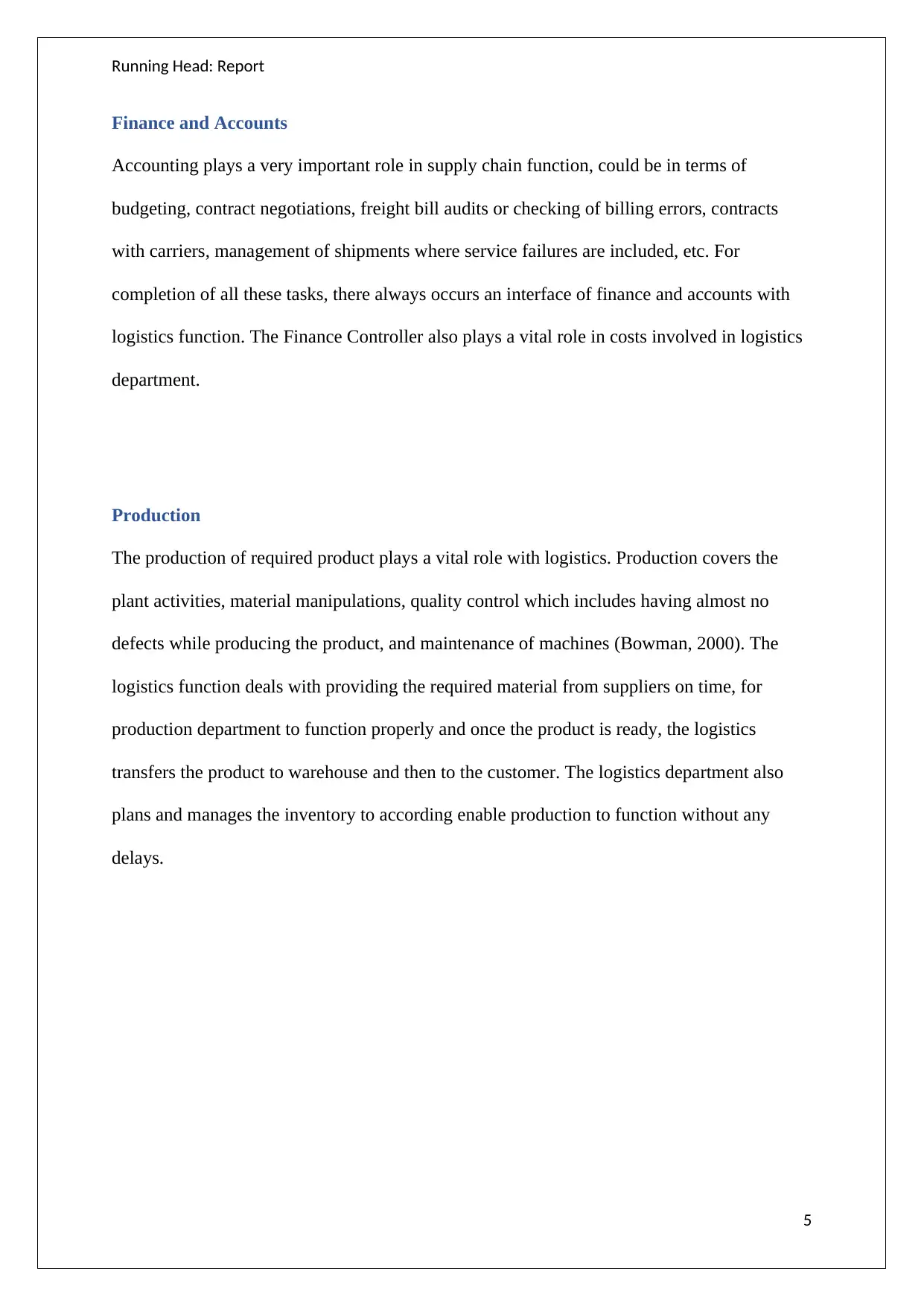
Running Head: Report
Finance and Accounts
Accounting plays a very important role in supply chain function, could be in terms of
budgeting, contract negotiations, freight bill audits or checking of billing errors, contracts
with carriers, management of shipments where service failures are included, etc. For
completion of all these tasks, there always occurs an interface of finance and accounts with
logistics function. The Finance Controller also plays a vital role in costs involved in logistics
department.
Production
The production of required product plays a vital role with logistics. Production covers the
plant activities, material manipulations, quality control which includes having almost no
defects while producing the product, and maintenance of machines (Bowman, 2000). The
logistics function deals with providing the required material from suppliers on time, for
production department to function properly and once the product is ready, the logistics
transfers the product to warehouse and then to the customer. The logistics department also
plans and manages the inventory to according enable production to function without any
delays.
5
Finance and Accounts
Accounting plays a very important role in supply chain function, could be in terms of
budgeting, contract negotiations, freight bill audits or checking of billing errors, contracts
with carriers, management of shipments where service failures are included, etc. For
completion of all these tasks, there always occurs an interface of finance and accounts with
logistics function. The Finance Controller also plays a vital role in costs involved in logistics
department.
Production
The production of required product plays a vital role with logistics. Production covers the
plant activities, material manipulations, quality control which includes having almost no
defects while producing the product, and maintenance of machines (Bowman, 2000). The
logistics function deals with providing the required material from suppliers on time, for
production department to function properly and once the product is ready, the logistics
transfers the product to warehouse and then to the customer. The logistics department also
plans and manages the inventory to according enable production to function without any
delays.
5
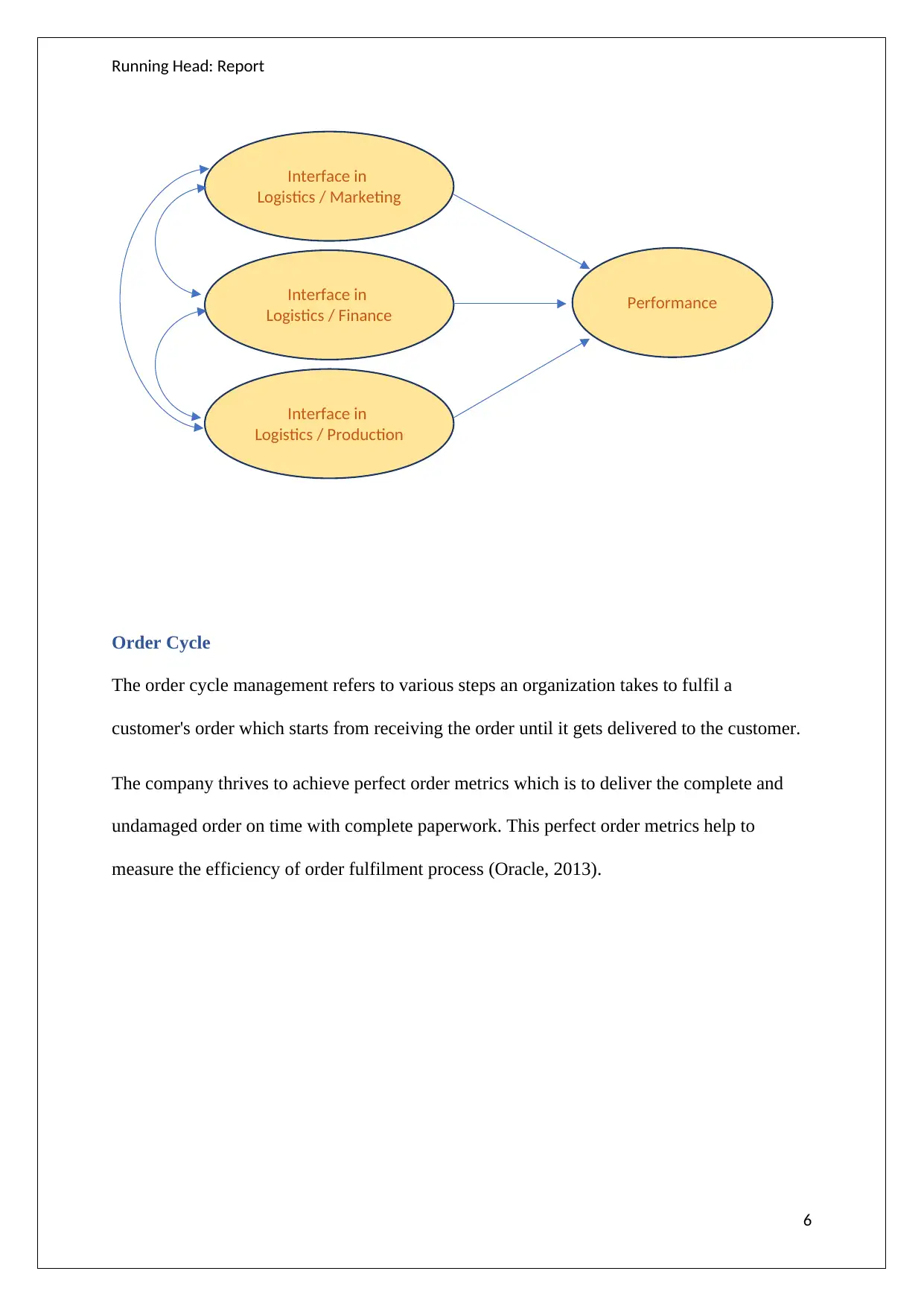
Interface in
Logistics / Marketing
Interface in
Logistics / Finance
Interface in
Logistics / Production
Performance
Running Head: Report
Order Cycle
The order cycle management refers to various steps an organization takes to fulfil a
customer's order which starts from receiving the order until it gets delivered to the customer.
The company thrives to achieve perfect order metrics which is to deliver the complete and
undamaged order on time with complete paperwork. This perfect order metrics help to
measure the efficiency of order fulfilment process (Oracle, 2013).
6
Logistics / Marketing
Interface in
Logistics / Finance
Interface in
Logistics / Production
Performance
Running Head: Report
Order Cycle
The order cycle management refers to various steps an organization takes to fulfil a
customer's order which starts from receiving the order until it gets delivered to the customer.
The company thrives to achieve perfect order metrics which is to deliver the complete and
undamaged order on time with complete paperwork. This perfect order metrics help to
measure the efficiency of order fulfilment process (Oracle, 2013).
6
⊘ This is a preview!⊘
Do you want full access?
Subscribe today to unlock all pages.

Trusted by 1+ million students worldwide

Receive the order (via email, phone or in person)Enter order into the ERP or accounting platformCustomer gets order received notification
Production is informed about the order
Product reaches warehouseOrder is picked and packed for shippingCustomer gets notification that order is on the way
Product reaches to customer
Running Head: Report
The below chart shows the general order cycle management flow step by step at Philips.
As a Logistics Manager at Philips, some challenges identified in the order cycle process are
mostly in the planning part, like demand and inventory planning, logistics planning. Hence,
the planning needs to be made more robust so as to improve the efficiency and effectiveness
of this process (Horning & McCann, 2003).
Demand planning can be dealt with forming a better interface with the marketing function to
understand in advance what the demand for a product might occur in near future. Inventory
planning can be made better have a better know how about the stocks and increasing
visibility once the order is placed so that backorders and delays gets prevented, and logistics
planning needs to be done simultaneously while the products are being prepared, to do all
pre-work about shipping time, documentation, precautions to be taken for careful delivery of
product without causing any damages.
7
Production is informed about the order
Product reaches warehouseOrder is picked and packed for shippingCustomer gets notification that order is on the way
Product reaches to customer
Running Head: Report
The below chart shows the general order cycle management flow step by step at Philips.
As a Logistics Manager at Philips, some challenges identified in the order cycle process are
mostly in the planning part, like demand and inventory planning, logistics planning. Hence,
the planning needs to be made more robust so as to improve the efficiency and effectiveness
of this process (Horning & McCann, 2003).
Demand planning can be dealt with forming a better interface with the marketing function to
understand in advance what the demand for a product might occur in near future. Inventory
planning can be made better have a better know how about the stocks and increasing
visibility once the order is placed so that backorders and delays gets prevented, and logistics
planning needs to be done simultaneously while the products are being prepared, to do all
pre-work about shipping time, documentation, precautions to be taken for careful delivery of
product without causing any damages.
7
Paraphrase This Document
Need a fresh take? Get an instant paraphrase of this document with our AI Paraphraser
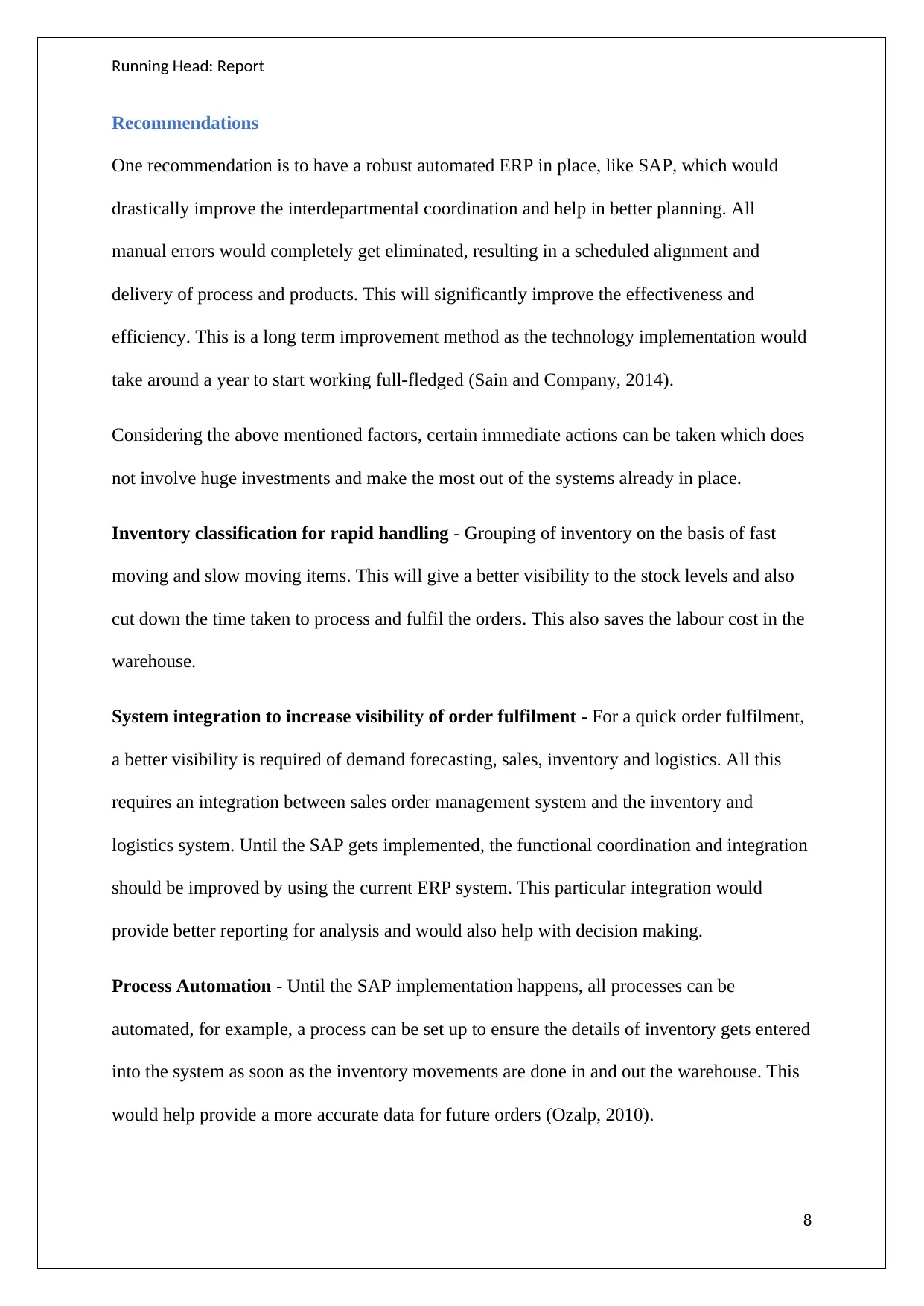
Running Head: Report
Recommendations
One recommendation is to have a robust automated ERP in place, like SAP, which would
drastically improve the interdepartmental coordination and help in better planning. All
manual errors would completely get eliminated, resulting in a scheduled alignment and
delivery of process and products. This will significantly improve the effectiveness and
efficiency. This is a long term improvement method as the technology implementation would
take around a year to start working full-fledged (Sain and Company, 2014).
Considering the above mentioned factors, certain immediate actions can be taken which does
not involve huge investments and make the most out of the systems already in place.
Inventory classification for rapid handling - Grouping of inventory on the basis of fast
moving and slow moving items. This will give a better visibility to the stock levels and also
cut down the time taken to process and fulfil the orders. This also saves the labour cost in the
warehouse.
System integration to increase visibility of order fulfilment - For a quick order fulfilment,
a better visibility is required of demand forecasting, sales, inventory and logistics. All this
requires an integration between sales order management system and the inventory and
logistics system. Until the SAP gets implemented, the functional coordination and integration
should be improved by using the current ERP system. This particular integration would
provide better reporting for analysis and would also help with decision making.
Process Automation - Until the SAP implementation happens, all processes can be
automated, for example, a process can be set up to ensure the details of inventory gets entered
into the system as soon as the inventory movements are done in and out the warehouse. This
would help provide a more accurate data for future orders (Ozalp, 2010).
8
Recommendations
One recommendation is to have a robust automated ERP in place, like SAP, which would
drastically improve the interdepartmental coordination and help in better planning. All
manual errors would completely get eliminated, resulting in a scheduled alignment and
delivery of process and products. This will significantly improve the effectiveness and
efficiency. This is a long term improvement method as the technology implementation would
take around a year to start working full-fledged (Sain and Company, 2014).
Considering the above mentioned factors, certain immediate actions can be taken which does
not involve huge investments and make the most out of the systems already in place.
Inventory classification for rapid handling - Grouping of inventory on the basis of fast
moving and slow moving items. This will give a better visibility to the stock levels and also
cut down the time taken to process and fulfil the orders. This also saves the labour cost in the
warehouse.
System integration to increase visibility of order fulfilment - For a quick order fulfilment,
a better visibility is required of demand forecasting, sales, inventory and logistics. All this
requires an integration between sales order management system and the inventory and
logistics system. Until the SAP gets implemented, the functional coordination and integration
should be improved by using the current ERP system. This particular integration would
provide better reporting for analysis and would also help with decision making.
Process Automation - Until the SAP implementation happens, all processes can be
automated, for example, a process can be set up to ensure the details of inventory gets entered
into the system as soon as the inventory movements are done in and out the warehouse. This
would help provide a more accurate data for future orders (Ozalp, 2010).
8

Running Head: Report
Inventory Management
Philips has a constantly changing product inventories, and hence the company keeps
struggling to increase its product visibility. Workers at Philips manufacturing and distribution
centers scan the product barcodes manually using a barcode reader to get retrieve inventory
details. These details were then updated in the ERP system. As the process is manual, it leads
to errors and discrepancies. These manual processes of scanning, packaging, stacking, etc. are
prone to errors and very time consuming. The discrepancies lead to process inefficiency and
the employees of the customer support department had no clarity how to respond to the
changing requests and track deliveries, they had no clear understanding about the inventory
status, the order status or if it is out for delivery then where has it reached. Hence the
performance of the customer support function was also getting hampered due to the
interlinked tasks.
Inventory management is one of the areas where Philips need to improve on, to get high
volume integrated circuits which would enable them to quickly revert to the customer
demands, eliminate errors and minimize wastes.
It is very important for the company to improve the efficiency and enhance the customer
service so as to gain confidence with their customers and sustain the further business with
them. Keeping the goals in mind, it is crucial to streamline information management
processes like capturing of inventory data, both at the production facility and at the logistics
facility, to speed up the inventory management processes and increase the accuracy of its
data, and update the ERP system accurately (Li, 2014).
9
Inventory Management
Philips has a constantly changing product inventories, and hence the company keeps
struggling to increase its product visibility. Workers at Philips manufacturing and distribution
centers scan the product barcodes manually using a barcode reader to get retrieve inventory
details. These details were then updated in the ERP system. As the process is manual, it leads
to errors and discrepancies. These manual processes of scanning, packaging, stacking, etc. are
prone to errors and very time consuming. The discrepancies lead to process inefficiency and
the employees of the customer support department had no clarity how to respond to the
changing requests and track deliveries, they had no clear understanding about the inventory
status, the order status or if it is out for delivery then where has it reached. Hence the
performance of the customer support function was also getting hampered due to the
interlinked tasks.
Inventory management is one of the areas where Philips need to improve on, to get high
volume integrated circuits which would enable them to quickly revert to the customer
demands, eliminate errors and minimize wastes.
It is very important for the company to improve the efficiency and enhance the customer
service so as to gain confidence with their customers and sustain the further business with
them. Keeping the goals in mind, it is crucial to streamline information management
processes like capturing of inventory data, both at the production facility and at the logistics
facility, to speed up the inventory management processes and increase the accuracy of its
data, and update the ERP system accurately (Li, 2014).
9
⊘ This is a preview!⊘
Do you want full access?
Subscribe today to unlock all pages.

Trusted by 1+ million students worldwide
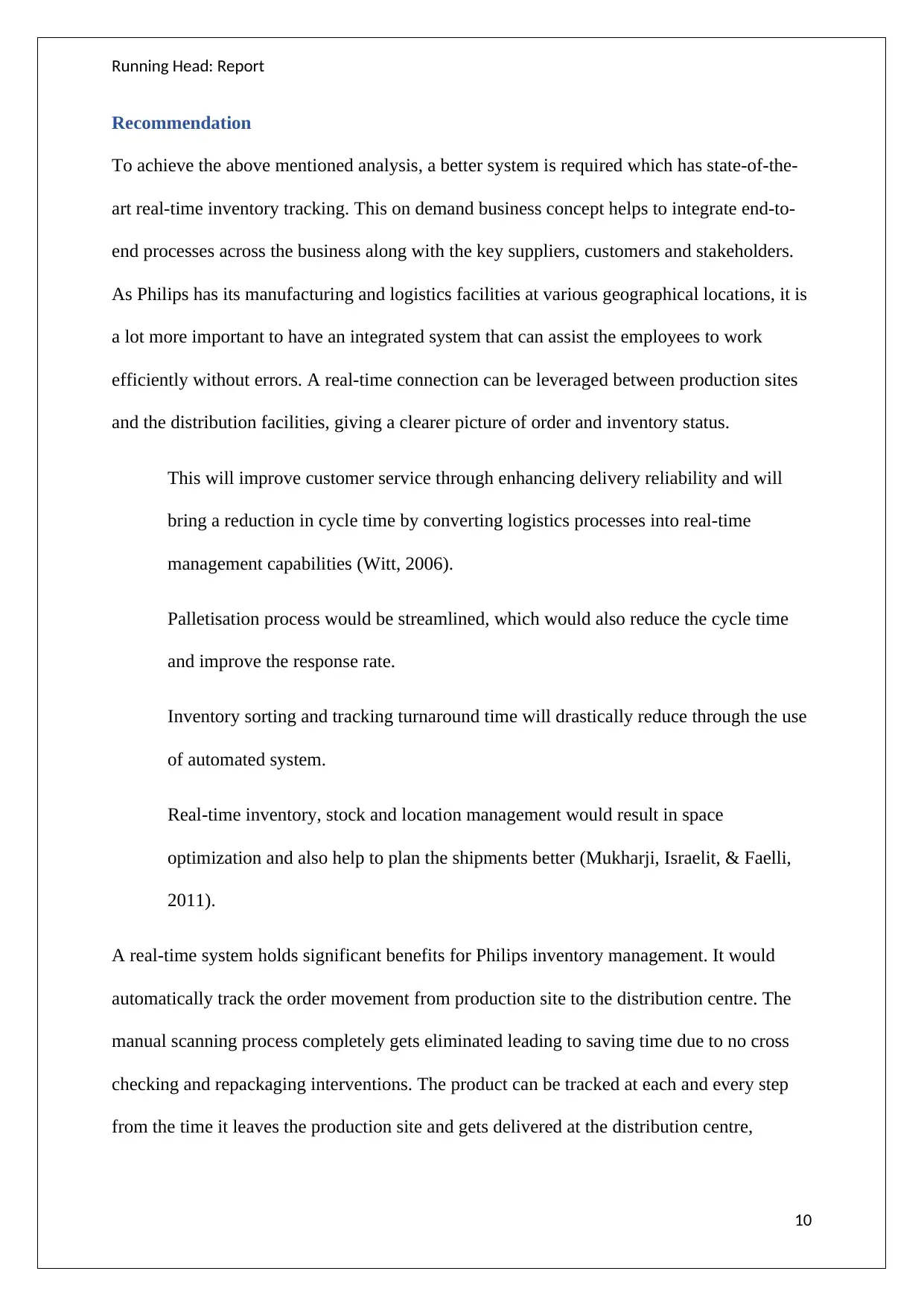
Running Head: Report
Recommendation
To achieve the above mentioned analysis, a better system is required which has state-of-the-
art real-time inventory tracking. This on demand business concept helps to integrate end-to-
end processes across the business along with the key suppliers, customers and stakeholders.
As Philips has its manufacturing and logistics facilities at various geographical locations, it is
a lot more important to have an integrated system that can assist the employees to work
efficiently without errors. A real-time connection can be leveraged between production sites
and the distribution facilities, giving a clearer picture of order and inventory status.
This will improve customer service through enhancing delivery reliability and will
bring a reduction in cycle time by converting logistics processes into real-time
management capabilities (Witt, 2006).
Palletisation process would be streamlined, which would also reduce the cycle time
and improve the response rate.
Inventory sorting and tracking turnaround time will drastically reduce through the use
of automated system.
Real-time inventory, stock and location management would result in space
optimization and also help to plan the shipments better (Mukharji, Israelit, & Faelli,
2011).
A real-time system holds significant benefits for Philips inventory management. It would
automatically track the order movement from production site to the distribution centre. The
manual scanning process completely gets eliminated leading to saving time due to no cross
checking and repackaging interventions. The product can be tracked at each and every step
from the time it leaves the production site and gets delivered at the distribution centre,
10
Recommendation
To achieve the above mentioned analysis, a better system is required which has state-of-the-
art real-time inventory tracking. This on demand business concept helps to integrate end-to-
end processes across the business along with the key suppliers, customers and stakeholders.
As Philips has its manufacturing and logistics facilities at various geographical locations, it is
a lot more important to have an integrated system that can assist the employees to work
efficiently without errors. A real-time connection can be leveraged between production sites
and the distribution facilities, giving a clearer picture of order and inventory status.
This will improve customer service through enhancing delivery reliability and will
bring a reduction in cycle time by converting logistics processes into real-time
management capabilities (Witt, 2006).
Palletisation process would be streamlined, which would also reduce the cycle time
and improve the response rate.
Inventory sorting and tracking turnaround time will drastically reduce through the use
of automated system.
Real-time inventory, stock and location management would result in space
optimization and also help to plan the shipments better (Mukharji, Israelit, & Faelli,
2011).
A real-time system holds significant benefits for Philips inventory management. It would
automatically track the order movement from production site to the distribution centre. The
manual scanning process completely gets eliminated leading to saving time due to no cross
checking and repackaging interventions. The product can be tracked at each and every step
from the time it leaves the production site and gets delivered at the distribution centre,
10
Paraphrase This Document
Need a fresh take? Get an instant paraphrase of this document with our AI Paraphraser

Running Head: Report
leading to streamlined order and inventory management process as well as improved
performance of customer support employees.
Conclusion
Services and products of a company are the main factors that differentiate that company from
the others in the market and that differentiating factor makes them a winner among the
competitors. For many of these companies the differentiating factor is the logistics
management of that company. For attaining excellence in logistics management, the
companies need to ensure that the critical supply chain processes are aligned with business
objectives and strategies. This alignment also extends to the internal functions as marketing,
production, finance and accounts, and to the external partners, like customers, suppliers and
third party vendors, so as to achieve similar expectations.
A streamlined process flow happening within the department and with other departments is
very critical to achieve effective and efficient logistics management. Even a single gap or
errors affect performance of all interlinked functions. Thus, an automated process that
eliminates all possibilities of errors is the most efficient and cost effective method to attain
sustainable logistics management function and gain a competitive edge in the market. The
approach needs to be correct at the first place to have real value when the information gets
acted upon to achieve the goal of excelling the effectiveness and efficiency in logistics
performance to a level of customer satisfaction.
11
leading to streamlined order and inventory management process as well as improved
performance of customer support employees.
Conclusion
Services and products of a company are the main factors that differentiate that company from
the others in the market and that differentiating factor makes them a winner among the
competitors. For many of these companies the differentiating factor is the logistics
management of that company. For attaining excellence in logistics management, the
companies need to ensure that the critical supply chain processes are aligned with business
objectives and strategies. This alignment also extends to the internal functions as marketing,
production, finance and accounts, and to the external partners, like customers, suppliers and
third party vendors, so as to achieve similar expectations.
A streamlined process flow happening within the department and with other departments is
very critical to achieve effective and efficient logistics management. Even a single gap or
errors affect performance of all interlinked functions. Thus, an automated process that
eliminates all possibilities of errors is the most efficient and cost effective method to attain
sustainable logistics management function and gain a competitive edge in the market. The
approach needs to be correct at the first place to have real value when the information gets
acted upon to achieve the goal of excelling the effectiveness and efficiency in logistics
performance to a level of customer satisfaction.
11
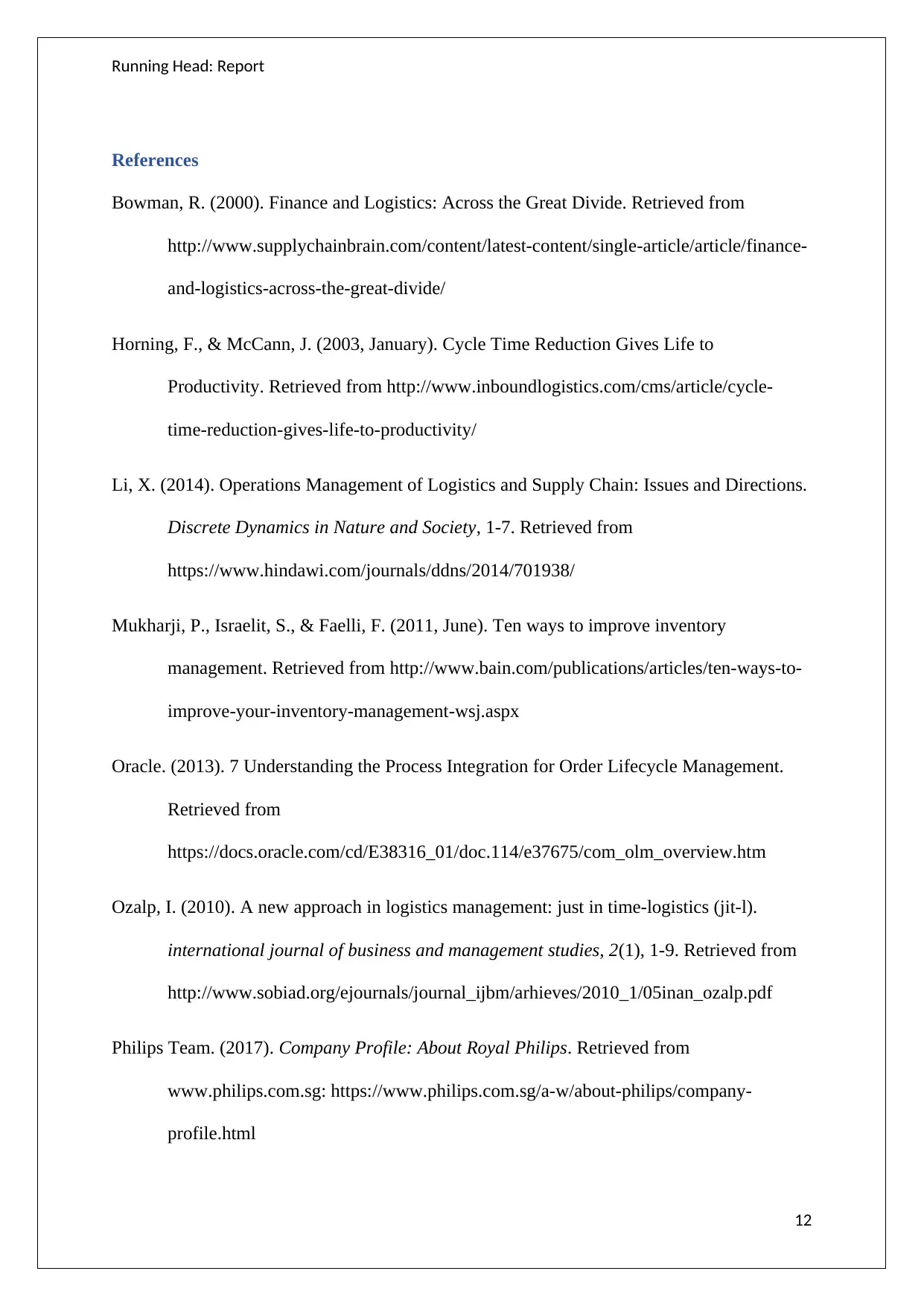
Running Head: Report
References
Bowman, R. (2000). Finance and Logistics: Across the Great Divide. Retrieved from
http://www.supplychainbrain.com/content/latest-content/single-article/article/finance-
and-logistics-across-the-great-divide/
Horning, F., & McCann, J. (2003, January). Cycle Time Reduction Gives Life to
Productivity. Retrieved from http://www.inboundlogistics.com/cms/article/cycle-
time-reduction-gives-life-to-productivity/
Li, X. (2014). Operations Management of Logistics and Supply Chain: Issues and Directions.
Discrete Dynamics in Nature and Society, 1-7. Retrieved from
https://www.hindawi.com/journals/ddns/2014/701938/
Mukharji, P., Israelit, S., & Faelli, F. (2011, June). Ten ways to improve inventory
management. Retrieved from http://www.bain.com/publications/articles/ten-ways-to-
improve-your-inventory-management-wsj.aspx
Oracle. (2013). 7 Understanding the Process Integration for Order Lifecycle Management.
Retrieved from
https://docs.oracle.com/cd/E38316_01/doc.114/e37675/com_olm_overview.htm
Ozalp, I. (2010). A new approach in logistics management: just in time-logistics (jit-l).
international journal of business and management studies, 2(1), 1-9. Retrieved from
http://www.sobiad.org/ejournals/journal_ijbm/arhieves/2010_1/05inan_ozalp.pdf
Philips Team. (2017). Company Profile: About Royal Philips. Retrieved from
www.philips.com.sg: https://www.philips.com.sg/a-w/about-philips/company-
profile.html
12
References
Bowman, R. (2000). Finance and Logistics: Across the Great Divide. Retrieved from
http://www.supplychainbrain.com/content/latest-content/single-article/article/finance-
and-logistics-across-the-great-divide/
Horning, F., & McCann, J. (2003, January). Cycle Time Reduction Gives Life to
Productivity. Retrieved from http://www.inboundlogistics.com/cms/article/cycle-
time-reduction-gives-life-to-productivity/
Li, X. (2014). Operations Management of Logistics and Supply Chain: Issues and Directions.
Discrete Dynamics in Nature and Society, 1-7. Retrieved from
https://www.hindawi.com/journals/ddns/2014/701938/
Mukharji, P., Israelit, S., & Faelli, F. (2011, June). Ten ways to improve inventory
management. Retrieved from http://www.bain.com/publications/articles/ten-ways-to-
improve-your-inventory-management-wsj.aspx
Oracle. (2013). 7 Understanding the Process Integration for Order Lifecycle Management.
Retrieved from
https://docs.oracle.com/cd/E38316_01/doc.114/e37675/com_olm_overview.htm
Ozalp, I. (2010). A new approach in logistics management: just in time-logistics (jit-l).
international journal of business and management studies, 2(1), 1-9. Retrieved from
http://www.sobiad.org/ejournals/journal_ijbm/arhieves/2010_1/05inan_ozalp.pdf
Philips Team. (2017). Company Profile: About Royal Philips. Retrieved from
www.philips.com.sg: https://www.philips.com.sg/a-w/about-philips/company-
profile.html
12
⊘ This is a preview!⊘
Do you want full access?
Subscribe today to unlock all pages.

Trusted by 1+ million students worldwide
1 out of 13
Related Documents
Your All-in-One AI-Powered Toolkit for Academic Success.
+13062052269
info@desklib.com
Available 24*7 on WhatsApp / Email
![[object Object]](/_next/static/media/star-bottom.7253800d.svg)
Unlock your academic potential
Copyright © 2020–2025 A2Z Services. All Rights Reserved. Developed and managed by ZUCOL.





